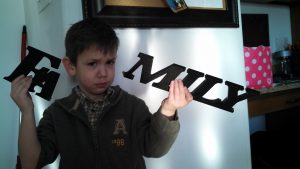By Dan Blair, marriage counselor and family counselor
Often when one thinks of discipline, you think of angry exchanges ending with both you and your child feeling frustrated and misunderstood. When people, especially kids, are upset, they lose ability to reason. Kids, and parents, also like the feeling when angry. It gives them a sense of power due to the release of endorphins, which can be addictive.Understanding why your child gets angry is a first step. Then you can catch their anger sooner. Triggers are external (like during transitions) and internal (fatigue, dietary, and sensory issues).
You usually won’t get a positive response unless you and your child are calm, so make that the priority. Your child will not be able to internalize learning unless your child is out of the fight or flight response. When your child is responsive, which means ready to listen, he or she can practice a skill you are trying to teach, instead of just giving them a consequence. You can remember this approach as “CPR: Calm, Practice, and Reinforce.”
Calm first. Don’t argue. Discipline should not exhaust the parent. Perhaps start by giving choices and perhaps compromising. Stress and anger are contagious, so how you feel when you are with the kids has more impact than what you say. Take the time to ask yourself, “What am I feeling?” If needed, take a break and separate, as long as the child is safe. When you return, give them reassurance that you can work this out to slowly turn off their brain’s alarm system. At some point you can show them you understand (you do not have to agree), or ask them to find your eyes, and if appropriate use touch. Maybe, let them talk without you countering to lower their emotional intensity. Learning emotional regulation skills is often more important than anything else at this point.
Physical and verbal aggression, however, is designed to shock, upset, and control you. Don’t let it work. If your child is too disruptive, and the attempts to calm are making it worse, lead the child to a safe place in the house. Give them space as long as the child is safe. If the child is dwelling in anger, the adrenaline is still triggered and unless the child is unsafe you may need to wait until the adrenaline is metabolized.
After a time, come back and model breathing, calming, distraction techniques. Do not correct behavior yet. You can also try releasing endorphins appropriately through stretching, walking backward, exercises, jumping, or swinging or other outlets. When the child is calm and ready to listen, the time-out can be over.
In general,
- Increase the amount of calm time spent together in the home.
- Create routine and warn about transitions ahead of time.
- Expectations should not be too high. Take it step by step.
Practice improves behavior better than reasoning with your child. The ability to calm needs practice during times the child is not upset. To only attempt calming techniques when someone is upset is like playing for a professional sports team without any practice. Practice the wrong way first to reinforce the difference. Introduce the option of a redo.
Another way to practice regulation is to come back to your senses. One way is to imagine a place where you or the child feels happy and safe through all five senses. For the sense of hearing, perhaps music, nature or relaxing sounds can help. For sight, pictures, mesmerizing objects or toys can be used. For touch, objects or toys of different textures can be options, or a bath or shower. Tastes include favorite flavors and textures (crunchy, spicy or sour). Even focusing on pleasurable scents can be relaxing. All focus on the senses should be accompanied by awareness of breathing with an emphasis on the out breath. You can also slowly use balloons, bubbles, or “hot cocoa breathing” (pretending to smell hot chocolate and gently blowing it so that it cools). The goal is muscle relaxation. Movement can also be used. Stretching, walking (or counting) backward, exercises, jumping, or swinging are possibilities. Just being around calm people, helping others and laughter are positive endorphin-releasing activities.
When you and your child are at ease, you can practice problem-solving and other skills. For problem-solving, you can use the “Triangle Approach”. The bottom corners of the triangle represent both sides of an issue. Both sides can share their perception of what happened. Each side shows understanding of the other side. Surprisingly, there is no need to agree or disagree to teach effectively. Then, instead of focusing on who is right or who is wrong, focus on the top of the triangle, which represents multiple brainstormed solutions. Agree on a solution to try, hopefully built on the kid’s ideas.
In general,
- Practice positive interactions to outweigh negative interactions.
- Spend time, talk, and show affection.
- Describe their accomplishments throughout the day.
Reinforce with routine privileges, plus special privileges at unexpected times, after calming and practicing. Identify which privileges are motivating so that they can be used to help the child focus. Privileges can be traded for responsibilities. Or perhaps a designated light can be used to indicate the use of privileges, and when it is turned off, privileges are on hold until responsibilities are completed. Or, use an old clock where you can move the hands to track the number of minutes earned to spend on their favorite privileges. Stickers, checklists, or other tokens can be used.
Use consequences that are logically related to the behavior if the problem reoccurs. Positive consequences include praise, celebrations, kids doing their own research on a topic, volunteering, or providing restitution. Consequences can vary but be consistent by using consequences. Empathize before giving a consequence. For older kids, have them suggest the consequence ahead of time.
In general,
- Negative reactions are powerful reinforcers of negative behavior.
- Long-term disadvantages exist for using fear, threats, and isolation
- Make the right behavior get better results for the child.
Using calm approaches, practicing skills, and positive reinforcers work in the long term, though punishment may be effective in the short term. The law of conflict means kids automatically oppose your position when they are upset, so adrenaline needs to be managed before teaching. The law of practice means that behavior is skill-based and requires repetition. Practice makes perfect, but practice can also make imperfect. Kids learn behavior more by watching than following instructions. The law of self-determination means that the more freedom is limited, the likelihood of a poor choice increases over time. Kids need to be able to make their own choices, and will learn best with consistent consequences.



